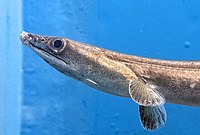
Kamaboko (蒲鉾:かまぼこ) is a type of cured surimi, a processed seafood product common in Japanese cuisine.

The sergeant major or píntano is a species of damselfish. It grows to a maximum length of about 22.9 centimetres (9.0 in).
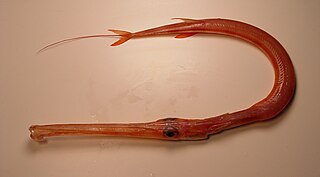
The red cornetfish, also known as the rough flutemouth, is a cornetfish of the family Fistulariidae, found in subtropical and tropical oceans worldwide, at depths between 10 m (33 ft) and 200 metres (660 ft). They are up to 2 m (6.6 ft) in length but rarely exceed 1 m (3.3 ft).

Satsuma-age (薩摩揚げ) is a fried fishcake originating from Kagoshima, Japan. Surimi and flour is mixed to make a compact paste that is solidified through frying. It is a specialty of the Satsuma region. It is known by a variety of regional names throughout Japan.

The longfin African conger or blacklip conger, is an eel of the family Congridae, found in the Indo-Pacific oceans from the Red Sea and East Africa to the Marquesas and Easter islands, north to southern Japan and the Ogasawara Islands, south to northern Australia and Lord Howe Island, at depths down to 80 m. Length is up to 1.3 m.

The European conger is a species of conger of the family Congridae. It is the heaviest eel in the world and native to the northeast Atlantic, including the Mediterranean Sea.

The blacktip grouper, also known as the redbanded grouper, blacktipped cod, black-tipped rockcod, footballer cod, red-barred cod, red-barred rockcod, scarlet rock-cod or weathered rock-cod, is a species of marine ray-finned fish, a grouper from the subfamily Epinephelinae which is part of the family Serranidae, which also includes the anthias and sea basses. It is found in the tropical Indo-Pacific region. It is the type species of the genus Epinephelus.

The fangtooth moray sometimes also known as tiger moray or bird-eye conger is a moray eel of the family Muraenidae found in warmer parts of the eastern Atlantic Ocean, including the Canary Islands, Madeira and various other islands. It entered the Mediterranean Sea from the Atlantic and is now found occasionally in the eastern Basin, from Levantine waters and off Turkey, Greece, Croatia and Sicily.
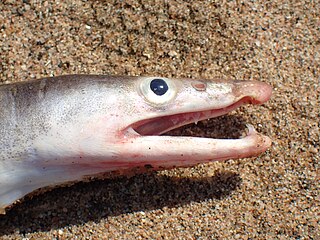
The common pike conger or pike eel is a species of eel found throughout most of the Indo-Pacific. In Australia, it is known in the southwest, in Western Australia, around the tropical north of the country, and south to the coast of New South Wales. The common pike conger grows up to 2 m in length and 7.1 kg (16 lb) in weight. A nocturnal predator, the common pike conger lives in estuaries and near the shore to a depth of 100 m (330 ft). A strong and muscular fish, the common pike conger is a delicacy in South East Asia and features in various dishes.
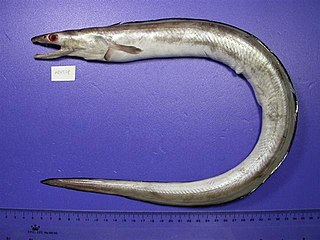
The Muraenesocidae, or pike congers, are a small family of marine eels found worldwide in tropical and subtropical seas. Some species are known to enter brackish water.

Eels are ray-finned fish belonging to the order Anguilliformes, which consists of eight suborders, 20 families, 164 genera, and about 1000 species. Eels undergo considerable development from the early larval stage to the eventual adult stage and are usually predators.

Muraenesox is a small genus of eels found throughout the Indo-Pacific. It currently has three described species as most species have been moved to other genera. Members are found in the Indo-West Pacific.

Huffmanela is a genus of parasitic nematodes, belonging to the family Trichosomoididae.

The Trichosomoididae is a family of nematodes.

Rhynchoconger trewavasae is an eel in the family Congridae. It was described by Adam Ben-Tuvia in 1993. It is a marine, deep water-dwelling eel which is known from the western Indian Ocean, including the Gulf of Aqaba and possibly the Gulf of Suez. A single specimen was recorded in the Mediterranean Sea from Israel in 1993. It dwells at a depth range of 300 to 500 metres, and swims in a zigzag motion near the bottom. Males can reach a maximum total length of 57 centimetres (22 in), but more commonly reach a TL of 45 centimetres (18 in).

The red pike conger is an eel in the family Muraenesocidae. It was described by David Starr Jordan and Charles Henry Gilbert in 1882, originally under the genus Muraenesox. It is a marine, tropical eel which is known from the eastern central and southeastern Pacific Ocean, including Mexico, Ecuador, Colombia, Costa Rica, Guatemala, El Salvador, Honduras, Panama, Peru, and Nicaragua. It dwells at a depth range of 10 to 100 metres, and inhabits sediments of sand and mud. Males can reach a maximum total length of 202 centimetres (80 in); the maximum recorded weight is 11.0 kilograms (24.3 lb).
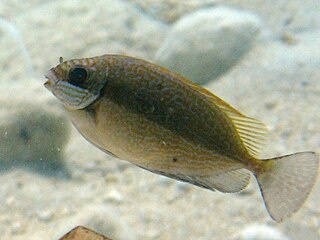
The dusky spinefoot, also known the squaretail rabbitfish,is a species of marine ray-finned fish, a rabbitfish belonging to the family Siganidae. It is native to the western Indian Ocean which has spread to the Mediterranean Sea through the Suez Canal. Its fin spines contain venom. It is regarded as a food fish.

Huffmanela hamo is a parasitic nematode. It has been observed in the muscles of the dagger-tooth pike conger Muraenesox cinereus, a muraenesocid marine fish off Japan. Its life-cycle is unknown.

Lagocephalus sceleratus, commonly known as the silver-cheeked toadfish, or Sennin-fugu, is an extremely poisonous marine bony fish in the family Tetraodontidae.

Kamitsukasa Shōken was a Japanese novelist and literary critic. Although having initially only primary school education he became a teacher, then joined the editorial staff of Yomiuri Shimbun in 1897, and worked his way up to become chief editor of its literary department until retirement in 1916. He was elected to the Japan Art Academy in 1937. Having begun with stories of local life in Osaka he later took up socialist themes.

